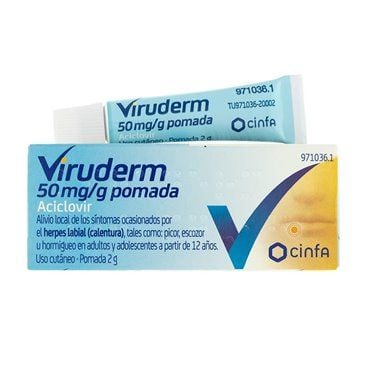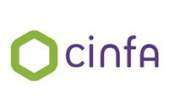Viruderm 50 Mg/G Ointment 1 Tube 2 G
It is indicated for the local relief of symptoms caused by cold sores (fever), such as: itching, stinging or tingling in adults and adolescents from 12 years of age.
It is indicated for the local relief of symptoms caused by cold sores (fever), such as: itching, stinging or tingling in adults and adolescents from 12 years of age.
Viruderm (50 Mg/G Ointment 1 Tube 2 G)
Acyclovir 50Mg/G
ACTION AND MECHANISM
- Antiviral. Acyclovir is a virostatic with a structure analogous to guanosine, which inhibits the cellular synthesis of viral DNA.
The antiviral action is manifested only in viruses in the replication phase. This selective action is due to the fact that its first phosphorylation to acyclovir monophosphate involves an enzyme of the virus, thymidine kinase, an enzyme for which acyclovir shows 200 times more affinity than for the human enzyme. In cells not infected by the virus, this first phosphorylation is very slow. Subsequent phosphorylations to the active form of the drug, acyclovir triphosphate, are carried out by cellular enzymes.
Acyclovir triphosphate is capable of inhibiting viral replication in three ways:
* Selective inhibition of viral DNA polymerase.
* Competition between acyclovir triphosphate and guanosine triphosphate for incorporation into viral DNA.
* Chain interruption upon incorporation into viral DNA.
It is especially active against herpes simplex virus (HSV) types 1 and 2, and varicella zoster virus. In descending order, it also exhibits in vitro activity against Epstein-Barr virus (EBV), human herpes virus type 6 (HHV-6), and cytomegalovirus (CMV). Against CMV (virus without thymidine kinase) its activity is much lower than that of famciclovir or foscarnet.
PHARMACOKINETICS
- Absorption: acyclovir barely crosses intact skin, reaching undetectable levels (<0.01 mcg/ml) after administration 4 times a day for 7 days. In skin of people with herpes zoster, cp of 0.01-0.28 mcg/ml are reached.
- Distribution: low binding to plasma proteins (9-33%). Its Vd is 0.8 l/kg.
- Metabolism: undergoes partial metabolism by hydroxylation and oxidation reactions. Two metabolites have been described, 8-hydroxy-acyclovir and 9-carboxymethoxy-methyl-guanine, both of which are inactive.
Enzymatic inducing/inhibitory capacity : it does not seem to have significant effects.
- Elimination: fundamentally in urine in unchanged form. After topical administration, between 0.02-9.4% of the dose is recovered unchanged in urine. His CLr is 173-353 ml/min/1.73 m2 and t1/2 2.5-3.3 h.
Pharmacokinetics in special situations :
- Renal insufficiency: an increase in cp has been observed, with values of 0.78 mcg/ml. However, due to its minimal topical absorption it seems unlikely that this is significant.
- Other situations: no data are available on how age or degree of hepatic function could affect the pharmacokinetics of acyclovir after topical administration.
INDICATIONS
Labial:
- Treatment of the symptoms of [HERPES SIMPLE LABIAL], such as itching, stinging or tingling.
POSOLOGY
- Adults: apply a thin layer on the lesions 5 times a day, approximately every 4 hours, omitting the application during sleeping hours at night. To achieve maximum effectiveness, it is important to start treatment as soon as possible, as soon as the first symptoms appear.
- Children and adolescents < 18 years: does not require dosage adjustment. Perform under medical supervision.
- Elderly: does not require dosage adjustment.
Treatment duration: 5 days. If complete healing has not occurred, continue for 5 more days up to a total of 10 days. If symptoms worsen or do not improve within this period, reassess the diagnosis.
Missed dose: Administer the next dose at the usual time. Do not double the next dose.
DOSAGE IN RENAL INSUFFICIENCY
No specific dosage recommendations have been made.
DOSAGE IN HEPATIC INSUFFICIENCY
No specific dosage recommendations have been made.
RULES FOR CORRECT ADMINISTRATION
Wash your hands before and after applying the medication, as well as avoid, if possible, rubbing the lip lesions with your hands or towels, so that the infection does not worsen or spread to other parts of the body or to other people, since it is a contagious process.
CONTRAINDICATIONS
- Hypersensitivity to acyclovir, valacyclovir or any other component of the drug.
PRECAUTIONS
- [IMMUNODEFICIENCY]. In severely immunosuppressed patients, such as [HIV INFECTION] or patients undergoing [TRANSPLANTATION], the use of topical acyclovir could be insufficient to combat the infection. The use of oral acyclovir should be considered.
ADVICE TO THE PATIENT
- Treatment should be started as soon as possible after the onset of symptoms.
- Acyclovir does not prevent transmission of the virus. Therefore, precautions must be taken to reduce the risk of possible contagion, such as avoiding contact of the lesions with the hands or other objects.
- Check with your doctor if symptoms worsen or do not improve after using acyclovir for 10 days.
- Avoid application on eyes or mucous membranes.
SPECIAL WARNINGS
- Treatment should be started as soon as the first symptoms appear.
- Patients with severe infection, severe immunosuppression or frequent recurrences may require oral acyclovir to control the infection.
- It is recommended to carry out a differential diagnosis in young children in case of a possible first herpes infection, since the symptoms could be confused with other oral or dentition disorders.
INTERACTIONS
They have not been described. It is unlikely due to its minimal absorption.
PREGNANCY
Safety in Animals : No detrimental effects on pregnancy, embryofoetal development, parturition, or postnatal development have been observed.
Safety in humans : Adequate and well-controlled studies in humans are not available. There are very limited data on use in pregnant women, where no side effects on the fetus have been observed. Its administration is only accepted if there are no safer therapeutic alternatives, and the benefits outweigh the possible risks.
Effects on Fertility : No specific studies have been conducted in humans using the topical route. Its systemic administration did not negatively affect sperm (morphology, motility, count).
LACTATION
Safety in animals: no data available.
Safety in humans: acyclovir is excreted in milk. After administration of 200 mg 5 times a day, concentrations in milk were obtained 0.6-4.1 times the maternal cp, which would mean a dose for the infant of 0.3 mg/kg/24 h. However, it is estimated that due to its poor skin absorption, the levels in milk would be minimal. Its administration is only accepted if there are no safer therapeutic alternatives, and the benefits for the mother outweigh the possible risks for the infant.
CHILDREN
No specific problems have been described in children that require dosage adjustment. It is recommended to use under medical recommendation, especially in < 12 years.
Cold sores are a recurrence of an infection inside the mouth that is usually contracted at an early age. A first medical diagnosis is recommended in children, since the symptoms of the first infection could go unnoticed or be confused with disorders of the dentition or other oral processes.
ELDERLY
No specific problems have been described in the elderly that require a dosage readjustment.
EFFECTS ON DRIVING
It does not seem to have a significant effect.
ADVERSE REACTIONS
Adverse reactions are described according to each frequency interval, being considered very common (>10%), common (1-10%), uncommon (0.1-1%), rare (0.01-0.1%) , very rare (<0.01%) or of unknown frequency (cannot be estimated from the available data).
- Dermatological: infrequent local reactions in the area of application, such as a local burning sensation, [PRURITO], [DRY SKIN], [SKIN DESCAMATION]; rare [ERITEMA], [CONTACT DERMATITIS].
- Allergic: very rare [HYPERSENSITIVITY REACTIONS], including [ANGIOEDEMA].
OVERDOSE
Symptoms: Significant intoxication is unlikely due to its route of administration. After accidental ingestion of 10 g of cream (500 mg of acyclovir) no symptoms have been described. There have been cases of patients who received up to 20 g orally, without presenting symptoms.
Measures to take:
- Antidote: there is no specific antidote.
- General elimination measures: although it does not seem necessary to take any measures, acyclovir is eliminated by haemodialysis.
- Monitoring: clinical status of the patient.
- Treatment: symptomatic.



